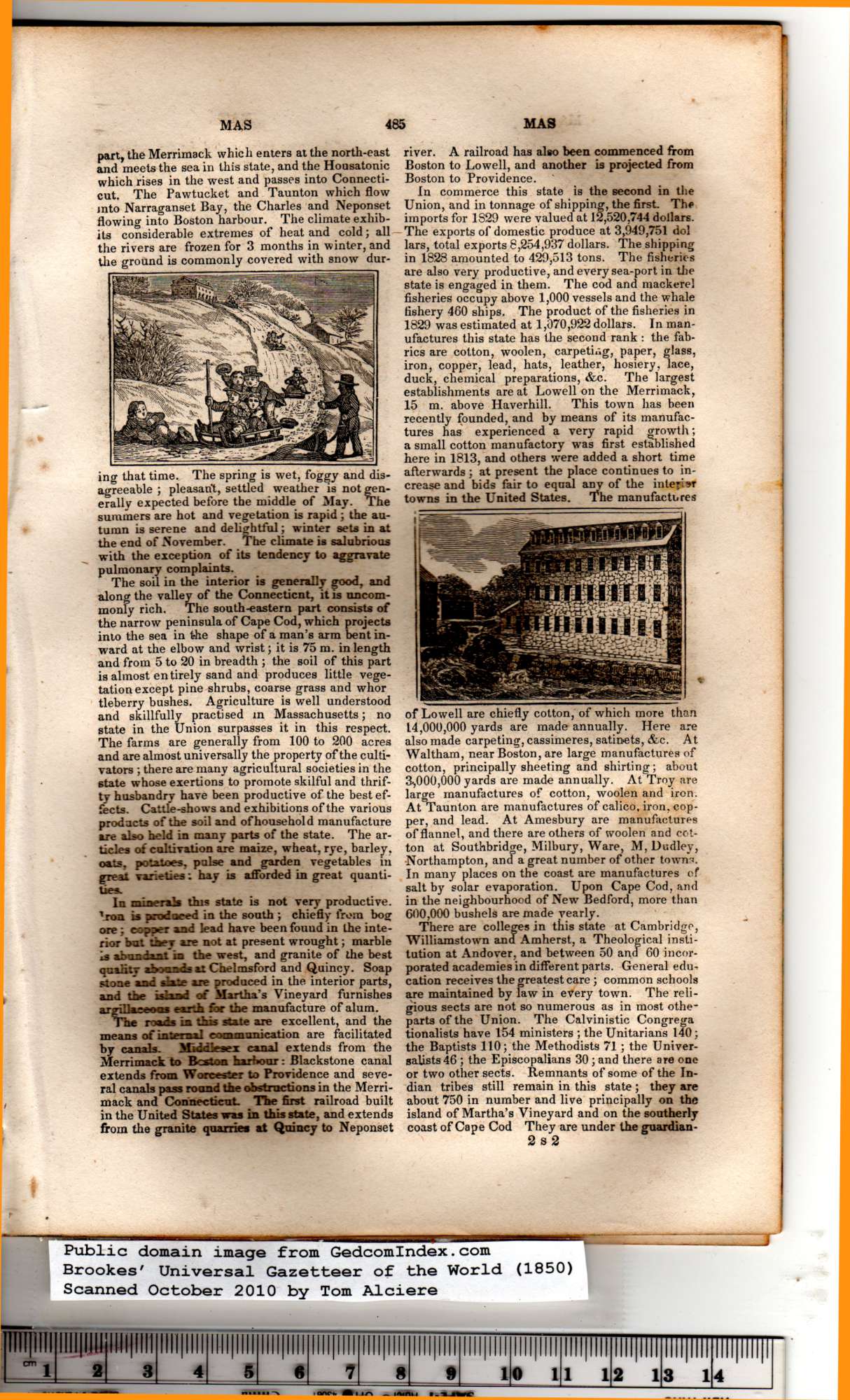|
part, the Merrimack which enters at the north-east
and meets the sea in this state, and the Hoosatonic
which rises in the west and passes into Connecti-
cut. The Pawtucket and Taunton which flow
into Narraganset Bay, the Charles and Neponset
flowing into Boston harbour. The climate exhib-
its considerable extremes of heat and cold; all
the rivers are frozen for 3 months in winter, and
the ground is commonly covered with snow dur-
ing that time. The spring is wet, foggy and dis-
agreeable ; pleasant, settled weather is not gen-
erally expected before the middle of May. The
summers are hot and vegetation is rapid; the au-
tumn is serene and dehghtful; winter sets in at
the end of November. The climate is salubrious
with the exception of its tendency to aggravate
pulmonary complaints.
The soil in the interior is generally good, and
along the valley of the Connecticnt, it is uncom-
monly rich. The south-eastern part consists of
the narrow peninsula of Cape Cod, which projects
into the sea in the shape of a man’s arm bent in-
ward at the elbow and wrist; it is 75 m. in length
and from 5 to 20 in breadth ; the soil of this part
is almost entirely sand and produces little vege-
tation except pine shrubs, coarse grass and whor
tleberry bushes. Agriculture is well understood
and skillfully practised in Massachusetts; no
state in the Union surpasses it in this respect.
The farms are generally from 100 to 200 acres
and are almost universally the property of the culti-
vators ; there are many agricultural societies in the
state whose exertions to promote skilful and thrif-
ty husbandry have been productive of the best ef-
fects. Cattle-shows and exhibitions of the various
products of the soil and of household manufacture
are also held in many parts of the state. The ar-
ticles of cultivation are maize, wheat, rye, barley,
oats, potatoes, pulse and garden vegetables in
great varieties: hay is afforded in great quanti-
ties.
In minerals this state is not very productive,
iron is produced in the south ; chiefly from bog
ore : copuer and lead have been found in the inte-
rior but they are not at present wrought; marble
is abundant in the west, and granite of the best
quality abounds at Chelmsford and Quincy. Soap
stoue and say are produced in the interior parts,
and the island of Martha’s Vineyard furnishes
argiUaseoas earth for the manufacture of alum.
The roads La this state are excellent, and the
means of internal communication are facilitated
by canals. Middlesex canal extends from the
Merrimack to Bcston harbour: Blackstone canal
extends from Worcester to Providence and seve-
ral canals pass round the obstructions in the Merri-
mack and Connecticut. The first railroad built
in the United States was in this state, and extends
from the granite quarries at Quincy to Neponset
river. A railroad has also been commenced from
Boston to Lowell, and another is projected from |
Boston to Providence.
In commerce this state is the second in the
Union, and in tonnage of shipping, the first. The
imports for 1S29 were valued at 12,520,744 dollars.
The exports of domestic produce at 3,949,751 dol
lars, total exports 8,254,937 dollars. The shipping
in 1828 amounted to 429,513 tons. The fisheries
are also very productive, and every sea-port in the
state is engaged in them. The cod and mackerel
fisheries occupy above 1,000 vessels and the whale
fishery 460 ships. The product of the fisheries in
1829 was estimated at 1,070,922 dollars. In man-
ufactures this state has the second rank: the fab-
rics are cotton, woolen, carpeting, paper, glass,
iron, copper, lead, hats, leather, hosiery, lace,
duck, chemical preparations, &c. The largest
establishments are at Lowell on the Merrimack,
15 m. above Haverhill. This town has been
recently founded, and by means of its manufac-
tures has experienced a very rapid growth;
a small cotton manufactory was first established
here in 1813, and others were added a short time
afterwards ; at present the place continues to in-
crease and bids fair to equal any of the inter ar
towns in the United States. The manufactures
of Lowell are chiefly cotton, of which more than
L4,000,000 yards are made annually. Here are
also made carpeting, cassimeres, satinets, &c. At
Waltham, near Boston, are large manufactures of
cotton, principally sheeting and shirting; about
3-,000,000 yards are made annually. At Troy are
large manufactures of cotton, woolen and iron.
At Taunton are manufactures of calico, iron, cop-
per, and lead. At Amesbury are manufactures
of flannel, and there are others of woolen and cot-
ton at Southbridge, Milbury, Ware, M, Dudley,
Northampton, and a great number of other town s.
In many places on the coast are manufactures of
salt by solar evaporation. Upon Cape Cod, and
in the neighbourhood of New Bedford, more than
600,000 bushels are made yearly.
There are colleges in this state at Cambridge,
Williamstown and Amherst, a Theological insti-
tution at Andover, and between 50 and 60 incor-
porated academies in different parts. General edu-
cation receives the greatest care ; common schools
are maintained by law in every town. The reli-
gious sects are not so numerous as in most othe-
parts of the Union. The Calvinistic Congrega
tionalists have 154 ministers ; the Unitarians 140;
the Baptists 110; the Methodists 71; the Univer-
salists46; the Episcopalians 30; and there are one
or two other sects. Remnants of some of the In-
dian tribes still remain in this state ; they are
about 750 in number and live principally on the
island of Martha’s Vineyard and on the southerly
coast of Cape Cod They are under the guardian-
2 s 2 |
